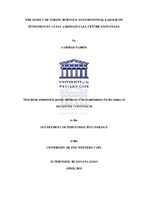| dc.description.abstract | The increasing demand for client-centred services in a highly competitive business environment has resulted in a substantial increase in the number of call centres world wide (Knight 2004 cited in Carrim, Basson & Coetzee, 2006; Nel & De Villiers 2004 cited in Carrim et al., 2006; Williams, 2000 cited in Carrim et al., 2006). According to Holdsworth and Cartwright (2003); Malhotra and Mukherjee (2004); Singh and Goolsby (1994), the work of a customer service representative is seen as one of the ten most stressful jobs in the present-day world economy. Customer service representatives are highly susceptible to elevated levels of stress and burnout, more so than in any other work environment. Within the call centre environment specifically, turnover has been identified as one of
the most pressing problems in terms of scope (levels or percentages of turnover), cost and productivity (O’Herron, 2003 cited in Spies, 2006). Factors that lead to unhappiness in call centres are, inter alia, the monotony and repetitiveness of the job content. This situation is aggravated by lack of opportunities for promotion and by stress (Worldroom Digest, 2004 cited in Carrim et al., 2006). In addition, Hochschild (1983) posits that organisations in the service industry do not hesitate to “commercialize” employees’ emotions as a means to attract and retain customers. Research suggests that service providers are under implicit and explicit pressure to regulate their emotions as a tool to lure customers into patronizing the organisation. In recent studies, several key factors were identified that are commonly associated with turnover intention among customer service representatives, namely, work overload, monitoring and surveillance of employees, competing management goals,
upward career movement, lack of skill variety, and emotional labour (Cordes & Dougherty, 1993; Deery et al., 2002; Deery & Kinnie, 2004; Holman, 2004; Singh, 2000; Zapf, Isic, Bechtoldt & Blau, 2003). If not dealt with appropriately, stress, burnout and emotional labour can increase the turnover rate, which accordingly can be damaging to the organisation. The current research was conducted at an outbound call centre in a retail organisation in the Western Cape. The sample comprised of a hundred and sixty three call centre employees who are employed in the collections/outbound department. Convenience sampling was utilised. A self-developed Biographical Questionnaire, the Maslach Burnout Inventory (Maslach & Jackson, 1981), the Emotional Labour Scale (Brotheridge & Lee, 2003), the Experience of Work and Life Circumstances Questionnaire (Van Zyl &Van der walt, 1994), and the Turnover Intentions Questionnaire (Roodt, 2004) were used to collect the data. The data was analysed
using SPSS and the results were interpreted by means of descriptive and inferential statistics (the Pearson Product-Moment Correlation Coefficient, T-Test, Analysis of Variance (ANOVA) and Multiple Regression Analysis. The results indicate that there is a moderate relationship between stress and intention to leave the organisation amongst the sample of employees. There was also a significant relationship between burnout and intention to leave the organisation. Moreover, there was a significant relationship between emotional labour and intention to leave the organisation. Further findings of the current study are: there are significant differences in stress based on employees’ gender and tenure, a significant difference in burnout with regards to gender and employment type, and significant differences between emotional labour based on gender and tenure. However, no significant difference was found between burnout and tenure, nor was there a significant difference between emotional labour and employment type. Recommendations are made to alleviate the effects of stress on call centre employees which in turn, will minimise the effects of burnout and emotional labour. Recommendations included the development of wellness programmes, stress management programmes, coping programmes and effective communications as a mean to shape employee perceptions regarding their interpretation of organisational demands, threats or opportunities and to enhance call centre employees’ performance within their work. | en_US |

